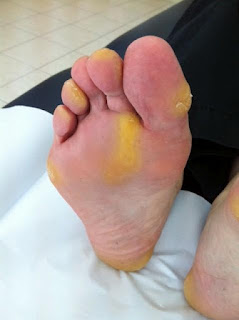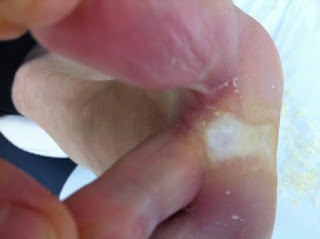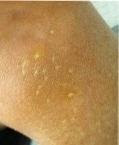CORNS, THEIR FANCY NAMES AND HOW THEY OCCUR by Jun Morimoto of the Family Podiatry Centre
Mark Reyneker
HELOMA DURUM
Hard corns (Heloma Durum) are thickening and hardening of skin layer which appears cone shaped and pushed into the skin causing pain. It almost always co-exists with overlying callous (hyperkeratosis). It usually appears as yellowish thick hard skin with an underlying hard nucleus.
Corns are caused by excessive pressure and friction on the skin and are not a disease of the skin (1). Hard skin forms in attempt to protect the underlying structure but as it accumulates, it creates more pressure thereby generating a vicious cycle and resulting in corn formation (2). Hard corns usually appear on top of the toes and ball of the foot but it can appear in other areas where there are high pressure or friction forces on skin.
(A)
(B)
Photo (A) shows foot with hyperkeratosis.
Photo (B) The same foot, after removing callous revealing an underlying corn.
HELOMA MOLLE
Soft corns (Heloma Molle) are usually found in between toes, most often between the base of 4th and 5th toe. It is usually caused by prominent toe joints rubbing against other bony prominences on neighbouring toes. This is aggravated by wearing tight fitting shoes. It is difficult for perspiration to evaporate between the toes due to close contact and poor air circulation. Eventually, the sweatiness will cause maceration of skin (excessive moisture in the skin causing softening and whitening) and give a white rubbery appearance. This macerated mass can cause irritation in between toes and can be very uncomfortable to painful. Sometimes biomechanical abnormalities such as excess pronation, hypermobility of the toes can cause the problem (3). Hyperhydrosis (excessive sweating) of the foot also contributes to this problem increasing frictional forces and subsequent skin maceration.
(C)
(D)
Photo (C) is a picture of corn in between toe web space.
Photo (D) after removing overlying callous, underlying maceration of skin is revealed.
HELOMA MILLARE
Seed corns (Heloma Millare) are similar to hard corns but usually smaller, shallower and can exist in single or multiple sites. These can usually be found on the sole of the foot regardless of pressure areas. It is usually associated with dry skin and asymptomatic but can be as painful as a hard corn (3). Seed corns can be found without overlying callous unless they are found in the pressure areas of the feet.
(E)
Photo E is a picture of the heel with multiple seed corns. It shows mild overlying callous with dry surrounding skin.
PATHOLOGY OF A CORN
The skin consists of the epidermis (superficial layer) and the dermis (deep connective tissue layer) (4). The epidermis is a multilayered, stratified, cornified epithelium that exists to protect the body from a diverse range of external insults (5). It consists of fivedifferent cell layers, namely, stratum basale (the inner most layer of the epidermis), stratum spinosum, stratum glanulosum, stratum lucidum and stratum corneum (the outer most layer of the skin). The normal skin is continually renewed and this process is called keratinisation. The keratinocytes at the stratum basale continually divide and migrate to upper layers over the course of 4-6 weeks. As they migrate to upper layers, the keratinocytes become flatter and the increase cohesion between the skin cells create an effective barrier. When they reach the top layer of the epidermis, the keratinocytes are filled with keratin and become corneocytes. The corneocytes are technically dead cells, however they are still able to release growth factors (3). They lose cohesion and naturally each corneocyte sheds from the skin surface in a process called desquamation.
(F) Anatomy of the skin(4)
When there is high pressure, friction or increase load on the skin, the corneocytes release growth factors and cause rapid keratinisation. Rapid keratinisation results in callous and corn formation as there is insufficient time for keratinocytes to mature normally. Slight fibrosis occurs in the dermis due to changes in the underlying microvasculature. Calloused skin has an altered structure and is less efficient in withstanding pressure and friction thereby easily damaging underlying structures (3).
TYPICAL CAUSES OF EXCESSIVE PRESSURE /FRICTION
Tight shoes and high heeled shoes will increase pressure over bony prominences and also push toes close together and increase pressure between toes. High heeled shoes will shift the body weight to the balls of the foot and increase forefoot pressure and result in corn formation.
Oversized shoes or slip on type shoes may seem better than tight shoes but they can cause problems too as your feet are not securely held in the shoes, your feet move and slide inside the shoes and cause excessive friction forces. Your toes try to grab the shoes to hold onto it thereby causing a secondary digital deformity of clawed toes.
Foot deformities such as hammer toes and clawed toes have more bony prominences and altered gait and pressure areas.It is difficult to accommodate them inside normal shoes and the disregard of such can cause high pressure and friction over the prominent joint areas and tip of the toes.
Flat feet or over pronated feet can cause areas of altered pressure during the walking cycle. Body weight is not evenly distributed and over load can occur at the balls of the foot, side the big toe and bunion area, the heel and cause friction and high pressure with each step (3). This repetitive excessive loading of body weight over one area causes corns to develop.
High arched feet tends to be less flexible than normal feet and have less shock absorption thus high impact goes through the foot with each step
Painful corns sometimes cause people to avoid putting pressure over the corns and walk on other part of the foot and that can increase pressure on new areas and create subsequent corns.
If corns are left untreated, it can cause skin breakdown under the corn and may cause infected wounds through broken skin.
TREATMENT
It is important to find out the cause of corns when treating them. Removal of corns alone is not an effective way to treat corns as there is a high recurrence rate if causes are not treated. Treatment for corns should involve symptomatic relief, identify the causes of the corn and prevention of recurrence.
Symptomatic relief involves removal of corns and usually will provide instant relief after removal. It should not be done at home or pedicure parlour and should be done by medical professionals like a Podiatrists. It is not advisable to use corn plaster as the acid in the corn plaster can penetrate deep and can cause skin ulceration.
Felt padding or silicon cushion will reduce excessive pressure over the affected area and reduce the chance of recurrence.
Good footwear will help to reduce painful corns. Wear deep and wide toe box shoes with lace ups or straps and with cushioning soles. Avoid wearing high heel shoes with thin soles. These shoes can make corns come back very quickly.
If biomechanical abnormalities such as flat feet or high arch feet are the contributing factors, custom made orthotics or offloading insoles are used to realign foot posture and redistribute body weight evenly.
Regular filing of hard skin (once weekly) using pumice stone or gentle foot file will help to reduce excess build up of callous and reduce corns. Application of moisturiser to hard skin will keep skin soft and supple and prevent skin becoming very hard.
For soft corns, dry between the toes carefully after shower to prevent maceration of the skin in between toes. If necessary, use surgical spirit between toes to dry up macerated skin. Wear absorbant socks and change them twice daily if you have sweaty feet. Never apply moisturisers between toes that will cause more maceration.
For seed corns, it is important to apply moisturising cream daily to prevent dry skin.
Corns can be prevented easily if the feet are looked after well. For chronic corns that appear on the same spot over and over again, you should seek professional medical help from a Podiatrist who will assess you for any biomechanical abnormalities that are causing problem.
Questions on this article can be emailed to foo...@familypodiatry.com.sg
References:
Freeman DB. Corns and Callouses Resulting from Mechanical hyperkeratosis. Am Fam Physician. 2002 Jun 1;65(11): 2277-2280
Singh D, Bentley G, Trevino SG. Callosities, corns, and calluses. BMJ. 1996 June 1; 312(7043): 1403–1406.
Lorimer D, French G, O’Donnell M, Burrow JG, Wall B. Neale’s Disorders of the Foot. 7th ed. Churchill Livingstone: Elsevier, 2006: 35, 453-456
Moore KL, Dalley AF, Agur AM. CLINICALLY ORIENTED ANATOMY. 6th ed. Lippincott Williams & Wilkins, 2010: 12-13.
McLean WHI, Irvine AD, Disorders of keratinisation: from rare to common genetic diseases of skin and other epithelial tissues. Ulster Med J. 2007 May; 76(2): 72–82.







